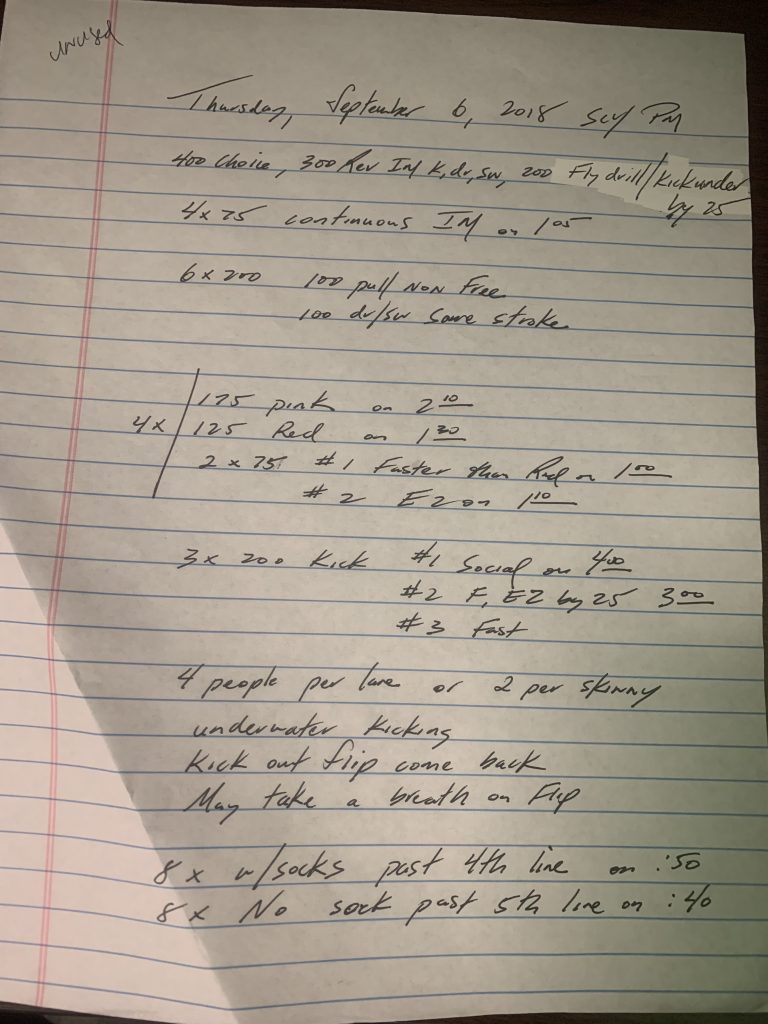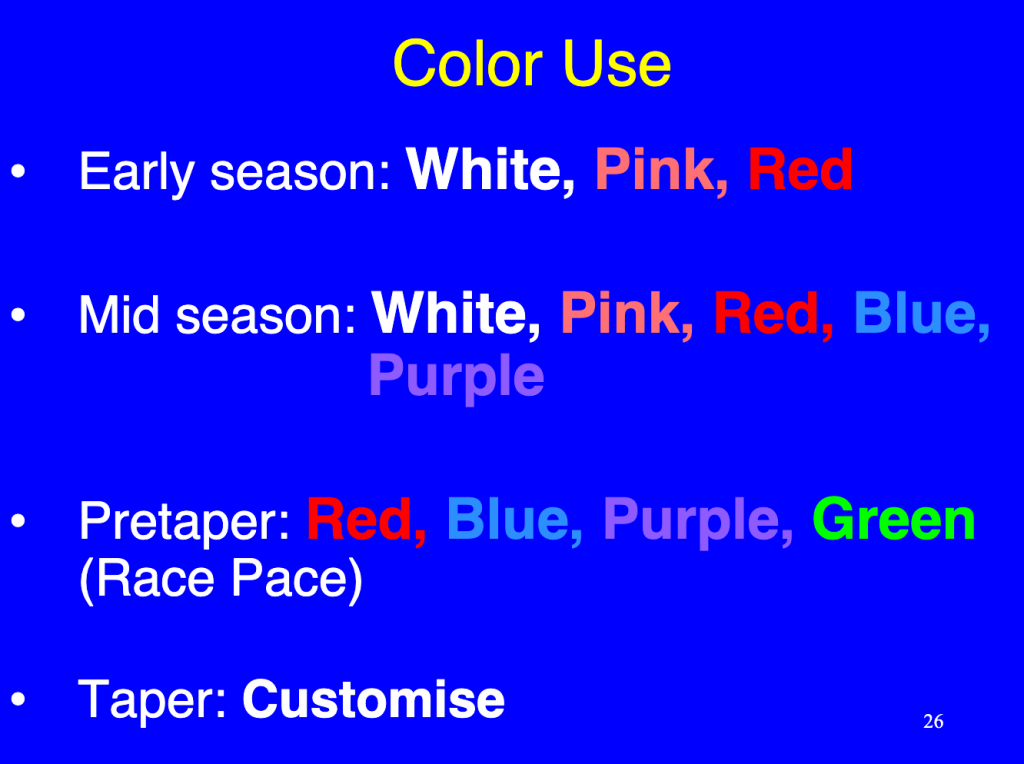There is NO DOUBT that if you’re a swim coach, you know the name: Jon Urbanchek. Jon Urbanchek is a legend within the swim world – most noticeably for his tenure in the Head Coaching Position at the University of Michigan. As an Olympic Coach, Jon single handedly changed the way swim training workouts were done through his color system. If you’re a newer coach and you’re looking to understand better how to periodize, write, and tweak your season plan – you need to make sure you’ve learned how Jon Urbancheck’s workouts work!
Let’s get started!
Why colors? I was first exposed to Jon’s Color System in college through legendary coach, Jack Bauerle. We had sets written on our workouts with the words: White, Pink, Red, and Purple beside them. As swimmers, we knew that these colors actually corresponded to our heart rate (and to the color of our faces by the end of them) – but I was never told why?

Jon Urbanchek Workouts: The Color System
EN-1: Aerobic (Oxidative):
In my brain it made logical sense to have levels within training. I studied Exercise Science in college and we always talked about the different energy systems and how to best train them — but that was always more so on land, than in the pool. What I didn’t realize for the longest time was Jon’s Color System is a way of doing that. The colors just dumb down, which energy system is being taxed – so you spend less time calculating the actual Heart Rate for that zone to your swimmer, and more so – they understand what the zone is be based off feel and the color of their face.
This zone is otherwise defined with colors white and pink. It is a very low intensity zone with 12 or more minutes of exercise, combined with short-rest (10-20 seconds per repeat) and has a heart rate between 120-150bpm.
EN-2 Mix of Aerobic/Anaerobic (Threshold):
I was on the phone yesterday with a group of coaches and we touched on the color system – actually what inspired me to write this blog and we all spoke about this is the zone, that matters the most. If you want to make the biggest changes in your swimmers ability to finish races, hold faster paces, and growing aerobically/anaerobically – it’s done within the colors of red and blue.
Red sets are considered “Threshold Sets”, which include 15-20 seconds of rest per repeat. They only last about 30-40 minutes, and the heart ranges from 150-170bpm.
Blue sets are considered sets that are slightly above threshold with 20-30 seconds rest per repeat. They are only 20-30 minutes in duration with a heart rate of 160-180bpm.
The biggest key between Red and Blue is the slight tweaks in rest, duration of the entire set, and heart rate level being higher.
EN-3 Race Pace Training:
Defined by the color of purple, Race Pace Training is training a swimmer at a 7% faster pace than their red pace. Sets can include rest from :30 seconds to 1:30 seconds. The intensity of this is very high with a high rate of 180-190bpm.
SP-1 Lactate Production:
Defined by the color of Green, Lactate training sets are much shorter in duration (10 seconds to 3 minutes in total). Include distances of 100 to 200 meters with lots of rest. Heart rate should be 175bpm or more.
Example sets include: 6×50 on 8:00 at 92% of their best time or 6×100 on 8:00 at 92% as well.
How to Apply the Color System?
Jon’s Color System is based applied through your season plan. In the early season when you have your swimmers creating an aerobic base, you’ll sift through the colors of white, pink, and red often. Midseason, you may introduce more blue and purple sets – on top of the others. By the time taper rolls around, you’ll have all the colors rolling – including more green sets.

There is a lot of debate on whether that foundation for aerobic training is needed due to the increase of Race Pace Training fans out there.
Olympian, Michael Andrew (most known for his endorsement) and outspokenness on Race Pace Training. Michael Phelps was the first to call Andrew out for his struggle to bring home the 200IM in Tokyo. Normally, Andrew is a bit more defiant against aerobic-based training but I guess when the Goat says the obvious – you have to admit it’s the truth. Read how Andrew said Phelps was right about his lack of base training here.
There’s no telling who is actually right in this scenario, or if there is an even a ‘right answer’ for all swimmers. That’s why I love the quote, “Training is Science, but Coaching is Art.” We must take into account the science behind our bodies, but the coach who writes the workout is an artist.
One of the biggest takeaways I took from my time in Australia is the Australians use Science to back everything they do in training. Americans don’t. I spent so much time watching lactate sets happen and calculating the mM in the blood. While we essentially did the same thing in college here, no one ever poked my ear on a regular basis. One could argue that leaves room for error, but our results on the world scene show that our best coaches can guess the heart rates of their swimmers pretty darn accurately.
Will we need to move in the direction of more science and less error? Maybe – but time will tell on that one.
Conclusion:
Season plans and training plans are key components to a swimmer’s success in the pool. If you need help with either of these pieces of your program, let us help you. Stay tuned for next week, where we discuss the fun part – does Jon’s Color System apply to Age Groupers as well?
Until Next Time,
Abbie Fish

11 Responses
One thing I’d like to see is how the colors are arranged in a weekly cycle. Including non free sets.
I’ll definitely take that into consideration for a future blog 🙂
Did you ever find out anything like this?
What do you mean?
How does this coach measure bpm during practice?
Different wearables can be used or the swimmers can count it themselves!
How about Ernie’s book “Swimming Even Faster”?
That’s a good one too!
Jon was the best of the best.
Question: Did not Ernie Maglisco develop the T-30 test.
It was really cool when I coached Ann Arbor swim club in the Mid90s as an assistant coach and then the late 90s is a head coach watching Jim and Jon do these color systems and how artistic and they laid it out for each kid and the T3 sets and the motivation that these boys and girls got at Michigan. It was so cool. I was a great educational experience and I think it can be tailored to today’s type of training and I think a lot of coaches are going that way so great article.
Appreciate the kind words so much! Do you still coach??